Indesit IWC 61251 User Manual

Instructions for use
WASHING MACHINE
GB |
|
ES |
|
IT |
|
|
|
|
|
|
|
English,1 |
Español, 13 |
Italiano, 25 |
|||
Contents |
GB |
|
Installation, 2-3
Unpacking and levelling
Connecting the electricity and water supplies
The first wash cycle
Technical data
AR PT
,37 |
Português, 49 |
IWC 61251
Description of the washing machine and starting a wash cycle, 4-5
Control panel Indicator lights Starting a wash cycle
Wash cycles, 6
Table of wash cycles
Personalisation, 7
Setting the temperature
Setting the spin speed
Functions
Detergents and laundry, 8
Detergent dispenser drawer
Preparing the laundry
Garments requiring special care
Load balancing system
Precautions and tips, 9
General safety
Disposal
Care and maintenance, 10
Cutting off the water or electricity supply Cleaning the washing machine Cleaning the detergent dispenser drawer
Caring for the door and drum of your appliance Cleaning the pump
Checking the water inlet hose
Troubleshooting, 11
Service, 12
1

Installation
! This instruction manual should be kept in a safe place for GB future reference. If the washing machine is sold, transferred
or moved, make sure that the instruction manual remains with the machine so that the new owner is able to familiarise himself/herself with its operation and features.
! Read these instructions carefully: they contain vital information relating to the safe installation and operation of the appliance.
Unpacking and levelling
Unpacking
1.Remove the washing machine from its packaging.
2.Make sure that the washing machine has not been damaged during the transportation process. If it has been damaged, contact the retailer and do not proceed any further with the installation process.
3. Remove the 3 protective screws (used during transportation) and the rubber washer with the corresponding spacer, located on the rear part of the appliance (see figure).
4.Close off the holes using the plastic plugs provided.
5.Keep all the parts in a safe place: you will need them again if the washing machine needs to be moved to another location.
! Packaging materials should not be used as toys for children.
Levelling
1. Install the washing machine on a flat sturdy floor, without resting it up against walls, furniture cabinets or anything else.
2. If the floor is not perfectly level, compensate for any unevenness by tightening or loosening the adjustable front feet (see figure); the angle of inclination, measured in relation to the worktop, must not exceed 2°.
Levelling the machine correctly will provide it with stability, help to avoid vibrations and excessive noise and prevent it from shifting while it is operating. If it is placed on carpet or a rug, adjust the feet in such a way as to allow a sufficient ventilation space underneath the washing machine.
Connecting the electricity and water supplies
Connecting the water inlet hose
1. Connect the supply pipe by screwing it to a cold water tab using a ¾ gas threaded connection (see figure).
Before performing the connection, allow the water to run freely until it is perfectly clear.
2. Connect the inlet hose to the washing machine by screwing it onto the corresponding water inlet of the appliance, which is situated on the top right-hand side of the rear part of the appliance (see figure).
3. Make sure that the hose is not folded over or bent.
!The water pressure at the tap must fall within the values indicated in the Technical details table (see next page).
!If the inlet hose is not long enough, contact a specialised shop or an authorised technician.
!Never use second-hand hoses.
!Use the ones supplied with the machine.
2
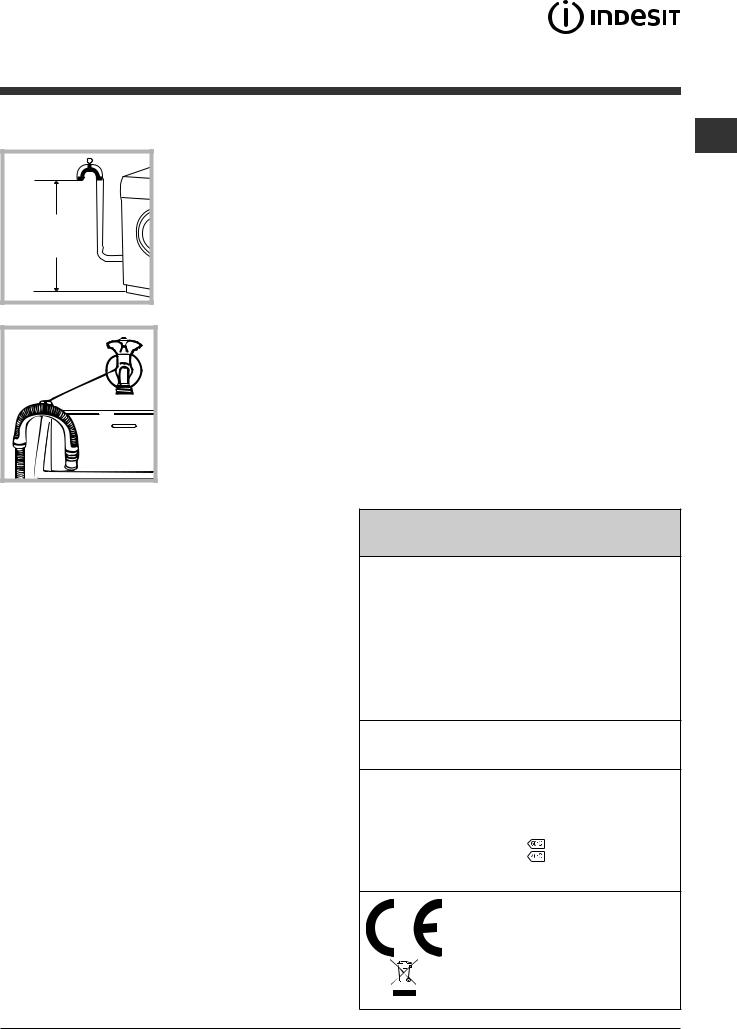
Connecting the drain hose
65 - 100 cm |
Connect the drain hose, without bending it, to a drainage duct or a wall drain located at a height between 65 and 100 cm from the floor;
alternatively, rest it on the side of a washbasin or bathtub, fastening the duct supplied to the tap (see figure). The free end of the hose should not be underwater.
! We advise against the use of hose extensions; if it is absolutely necessary, the extension must have the same diameter as the original hose and must not exceed 150 cm in length.
Electrical connections
Before plugging the appliance into the electricity socket, make sure that:
•the socket is earthed and complies with all applicable laws;
•the socket is able to withstand the maximum power load of the appliance as indicated in the Technical data table
(see opposite);
•the power supply voltage falls within the values indicated in the Technical data table (see opposite);
•the socket is compatible with the plug of the washing machine. If this is not the case, replace the socket or the plug.
!The washing machine must not be installed outdoors, even in covered areas. It is extremely dangerous to leave the appliance exposed to rain, storms and other weather conditions.
!When the washing machine has been installed, the electricity socket must be within easy reach.
! Do not use extension cords or multiple sockets.
GB
!The cable should not be bent or compressed.
!The power supply cable must only be replaced by authorised technicians.
Warning! The company shall not be held responsible in the event that these regulations are not respected.
The first wash cycle
Once the appliance has been installed, and before you use it for the first time, run a wash cycle with detergent and no laundry, using the wash cycle 2.
Technical data
Model |
IWC 61251 |
|
|
|
width 59.5 cm |
Dimensions |
height 85 cm |
|
depth 52,5 cm |
|
|
Capacity |
from 1 to 6 kg |
|
|
Electrical |
please refer to the technical data plate fixed |
connections |
to the machine |
maximum pressure 1 MPa (10 bar) Water connection minimum pressure 0.05 MPa (0.5 bar)
drum capacity 46 litres
Spin speed |
up to 1200 rotations per minute |
||
|
|
|
|
Test wash cycles |
|
|
|
in accordance |
Programme |
: Cotton standard 60°C; |
|
with directives |
|||
Programme |
: Cotton standard 40°C. |
||
1061/2010 and |
|||
|
|
||
1015/2010. |
|
|
|
This appliance conforms to the following EC
Directives:
-2004/108/CE (Electromagnetic Compatibility)
-2002/96/EC
- 2006/95/EC (Low Voltage)
3
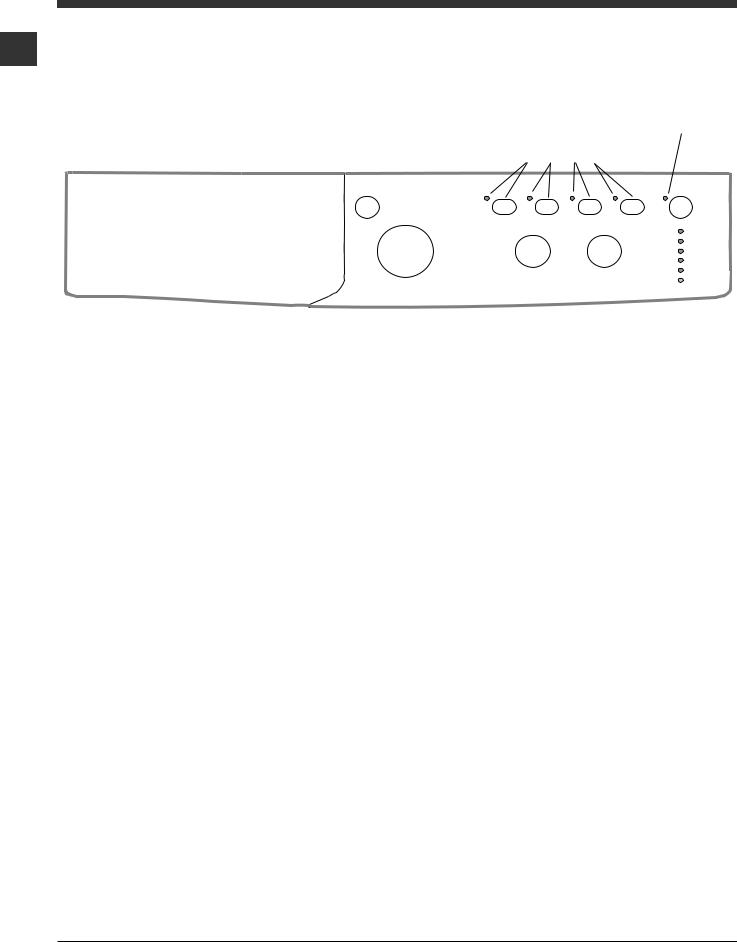
Description of the washing machine and starting a wash cycle
Control panel
GB
|
WASH CYCLE PROGRESS/ |
|||
|
DELAY TIMER indicator lights |
|||
|
FUNCTION |
|
|
START/ |
|
|
|
||
ON/OFF button |
|
|
PAUSE |
|
buttons with |
|
|
||
|
indicator lights |
|
|
button with |
|
|
|
indicator light |
|
|
|
|
|
|
|
|
|
|
|
|
|
|
|
|
|
|
|
|
|
|
|
|
|
|
|
|
|
|
|
|
|
|
|
|
|
|
|
TEMPERATURE |
|
|
|
|
|
|
|
|
|
|
|
|
|
|
DOOR LOCKED |
||
|
|
|
knob |
|
||
Detergent dispenser drawer |
|
|
||||
WASH CYCLE |
SPIN SPEED |
indicator light |
||||
|
|
|
|
|||
|
|
knob |
|
knob |
|
|
Detergent dispenser drawer: used to dispense detergents and washing additives (see “Detergents and laundry”).
ON/OFF button: switches the washing machine on and off.
WASH CYCLE knob: programmes the wash cycles. During the wash cycle, the knob does not move.
FUNCTION buttons with indicator light: used to select the available functions. The indicator light corresponding to the selected function will remain lit.
TEMPERATURE knob: sets the temperature or the cold wash cycle (see “Personalisation”).
SPIN SPEED knob: sets the spin speed or exclude the spin cycle completely (see “Personalisation”).
WASH CYCLE PROGRESS/DELAY TIMER indicator lights: used to monitor the progress of the wash cycle. The illuminated indicator light shows which phase is in progress.
If the Delay Timer function has been set, the time remaining until the wash cycle starts will be indicated (see next page).
DOOR LOCKED indicator light: indicates whether the door may be opened or not (see next page).
START/PAUSE button with indicator light: starts or temporarily interrupts the wash cycles.
N.B. To pause the wash cycle in progress, press this button; the corresponding indicator light will flash orange, while the indicator light for the current wash cycle phase will remain lit in a fixed manner. If the DOOR LOCKED  indicator light is switched off, the door may be opened. To start the wash cycle from the point at which it was interrupted, press this button again.
indicator light is switched off, the door may be opened. To start the wash cycle from the point at which it was interrupted, press this button again.
Standby mode
This washing machine, in compliance with new energy saving regulations, is fitted with an automatic standby system which is enabled after about 30 minutes if no activity is detected. Press the ON-OFF button briefly and wait for the machine to start up again.
Consumption in off-mode: 1 W Consumption in Left-on: 1 W
4
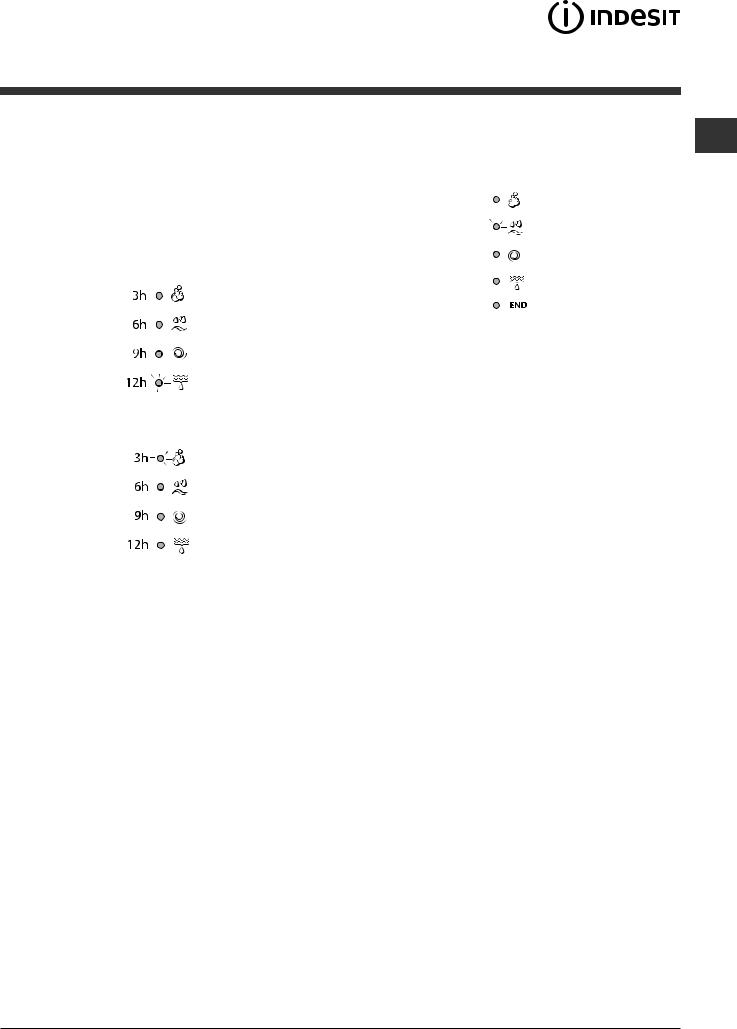
Indicator lights
The indicator lights provide important information. This is what they can tell you:
Delayed start
If the DELAY TIMER function has been activated (see “Personalisation”), after the wash cycle has been started the indicator light corresponding to the selected delay period will begin to flash:
As time passes, the remaining delay will be displayed and the corresponding indicator light will flash:
The set programme will start once the selected time delay has expired.
Wash cycle phase indicator lights
Once the desired wash cycle has been selected and has be- GB gun, the indicator lights switch on one by one to indicate which
phase of the cycle is currently in progress.
Wash
Rinse
Spin
Drain
End of wash cycle
Function buttons and corresponding indicator lights
When a function is selected, the corresponding indicator light will illuminate.
If the selected function is not compatible with the programmed wash cycle, the corresponding indicator light will flash and the function will not be activated.
If the selected function is not compatible with another function which has been selected previously, the indicator light corresponding to the first function selected will
flash and only the second function will be activated; the indicator light corresponding to the enabled option will
remain lit.
 Door locked indicator light
Door locked indicator light
When the indicator light is on, the porthole door is locked to prevent it from being opened; make sure the indicator light is off before opening the door (wait approximately 3 minutes). To open the door during a running wash cycle, press the START/PAUSE button; the door may be opened once the DOOR LOCKED indicator light turns off.
Starting a wash cycle
1.Switch the washing machine on by pressing the ON/OFF button. All indicator lights will switch on for a few seconds, then they will switch off and the START/PAUSE indicator light will pulse.
2.Load the laundry and close the door.
3.Set the WASH CYCLE knob to the desired programme.
4.Set the washing temperature (see “Personalisation”).
5.Set the spin speed (see “Personalisation”).
6.Measure out the detergent and washing additives (see “Detergents and laundry”).
7.Select the desired functions.
8.Start the wash cycle by pressing the START/PAUSE button and the corresponding indicator light will remain lit in a fixed manner, in green.
To cancel the set wash cycle, pause the machine by pressing the START/PAUSE button and select a new cycle.
9. At the end of the wash cycle the
 indicator light will switch on. The door can be opened once the DOOR LOCK
indicator light will switch on. The door can be opened once the DOOR LOCK  indicator light turns off. Take out your laundry and leave the appliance door ajar to make sure the drum dries completely. Switch the washing machine off by pressing the ON/OFF button.
indicator light turns off. Take out your laundry and leave the appliance door ajar to make sure the drum dries completely. Switch the washing machine off by pressing the ON/OFF button.
5
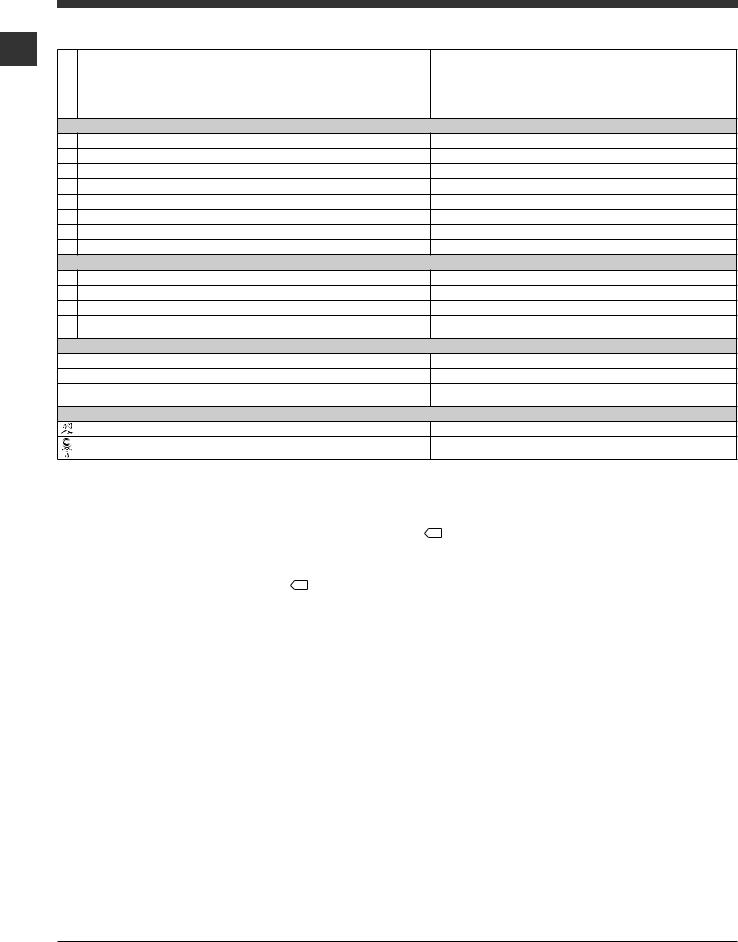
Wash cycles
Table of wash cycles
GB
cycles |
Description of the wash cycle |
|
Wash |
||
|
Daily
1 Cotton with prewash: extremely soiled whites.
2 Cotton: extremely soiled whites.
 Cotton Standard 60° (1): heavily soiled whites and resistant colours.
Cotton Standard 60° (1): heavily soiled whites and resistant colours.
 Cotton Standard 40° (2): lightly soiled whites and delicate colours.
Cotton Standard 40° (2): lightly soiled whites and delicate colours.
5 Coloured Cottons: lightly soiled whites and delicate colours.
6Synthetics: heavily soiled resistant colours.
6Synthetics (3): lightly soiled resistant colours.
7 Cotton Standard 20°C Special
8 Wool: for wool, cashmere, etc.
9 Silk/Curtains: for garments in silk and viscose, lingerie.
10 |
Jeans |
11 |
Express: to refresh lightly soiled garments quickly (not suitable for wool, silk and |
clothes which require washing by hand). |
|
|
Sport |
12 |
Sport Intensive |
13 |
Sport Light |
14 |
Special Shoes |
|
Partial wash cycles |
|
|
|
Rinse |
|
Spin + Drain |
|
|
Max. |
Max. |
Detergents |
loadMax.(kg) |
Residual dampness% |
Energy consumption kWh |
waterTotallt |
Cycle duration |
||||
Prewash |
|
Wash |
|
Fabric softener |
|||||||
temp. |
speed |
|
|
|
|
|
|
|
|
|
|
(°C) |
(rpm) |
|
|
|
|
|
|
|
|
|
|
90° |
|
|
|
|
|
|
|
|
|
|
150’ |
|
|
|
|
|
|
|
|||||
1200 |
|
|
6 |
53 |
1,84 |
64 |
|||||
90° |
1200 |
- |
|
|
|
|
6 |
53 |
1,77 |
58 |
135’ |
60° |
1200 |
- |
|
|
|
|
6 |
53 |
0,98 |
51 |
190’ |
40° |
1200 |
- |
|
|
|
|
6 |
53 |
0,86 |
52 |
185’ |
40° |
1200 |
- |
|
|
|
|
6 |
53 |
0,82 |
53 |
90’ |
60° |
800 |
- |
|
|
|
|
2,5 |
44 |
0,78 |
33 |
100’ |
40° |
800 |
- |
|
|
|
|
2,5 |
44 |
0,49 |
32 |
90’ |
20° |
1200 |
- |
|
|
|
|
6 |
- |
- |
- |
170’ |
40° |
|
|
|
|
|
|
|
|
|
|
70’ |
800 |
- |
|
|
1,5 |
- |
- |
- |
||||
30° |
0 |
- |
|
|
|
|
1 |
- |
- |
- |
55’ |
40° |
800 |
- |
|
|
|
|
3 |
- |
- |
- |
60’ |
30° |
800 |
- |
|
|
|
|
1,5 |
71 |
0,12 |
27 |
15’ |
30° |
|
|
|
|
|
|
|
|
|
|
85’ |
|
|
|
|
|
|
|
|
||||
600 |
- |
|
|
3 |
- |
- |
- |
||||
30° |
600 |
- |
|
|
|
|
3 |
- |
- |
- |
60’ |
30° |
600 |
- |
|
|
|
|
Max. |
- |
- |
- |
55’ |
|
|
2 pairs |
|||||||||
- |
|
|
|
|
|
|
|
|
|
36’ |
|
1200 |
- |
|
- |
|
6 |
- |
- |
- |
|||
- |
1200 |
- |
|
- |
|
- |
6 |
- |
- |
- |
16’ |
|
|
|
|
|
|
|
|
|
|
|
|
The length of cycle shown on the display or in this booklet is an estimation only and is calculated assuming standard working conditions. The actual duration can vary according to factors such as water temperature and pressure, the amount of detergent used, the amount and type of load inserted, load balancing and any wash options selected.
1) Test wash cycle in compliance with directive 1061/2010: set wash cycle  with a temperature of 60°C.
with a temperature of 60°C.
This cycle is designed for cotton loads with a normal soil level and is the most efficient in terms of both electricity and water consumption; it should be used for garments which can be washed at 60°C. The actual washing temperature may differ from the indicated value.
2) Test wash cycle in compliance with directive 1061/2010: set wash cycle 
 with a temperature of 40°C.
with a temperature of 40°C.
This cycle is designed for cotton loads with a normal soil level and is the most efficient in terms of both electricity and water consumption; it should be used for garments which can be washed at 40°C. The actual washing temperature may differ from the indicated value.
For all Test Institutes:
2)Long wash cycle for cottons: set wash cycle 
 with a temperature of 40°C.
with a temperature of 40°C.
3)Long wash cycle for synthetics: set wash cycle 6; with a temperature of 40°C.
Cotton Standard 20°C (wash cycle 7) ideal for heavily soiled cotton loads. The effective performance levels achieved at cold temperatures, which are comparable to washing at 40°, are guaranteed by a mechanical action which operates at varying speed, with repeated and frequent peaks.
Express (wash cycle 11) this wash cycle was designed to wash lightly soiled garments quickly: it lasts just 15 minutes and therefore saves both energy and time. By selecting this wash cycle (11 at 30°C), it is possible to wash different fabrics together (except for wool and silk items), with a maximum load of 1,5 kg.
Sport Intensive (wash cycle 12) is for washing heavily soiled sports clothing fabrics (tracksuits, shorts, etc.); for best results, we recommend not exceeding the maximum load indicated in the “Table of wash cycles”.
Sport Light (wash cycle 13) is for washing lightly soiled sports clothing fabrics (tracksuits, shorts, etc.); for best results, we recommend not exceeding the maximum load indicated in the “Table of wash cycles”. We recommend using a liquid detergent and dosage suitable for a half-load.
Special Shoes (wash cycle 14) is for washing sports shoes; for best results, do not wash more than 2 pairs simultaneously.
6

Personalisation
|
|
|
|
|
|
Setting the temperature |
|
|
|
||
|
|
GB |
|||
Turn the TEMPERATURE knob to set the wash temperature (see |
Table of wash cycles). |
||||
|
|||||
The temperature may be lowered, or even set to a cold wash . |
|
|
|
||
The washing machine will automatically prevent you from selecting a temperature which is higher than the maximum value |
|
||||
set for each wash cycle. |
|
|
|
||
Setting the spin speed |
|
|
|
||
Turn the SPIN SPEED knob to set the spin speed for the selected wash cycle. |
|
||||
The maximum spin speeds available for each wash cycle are as follows: |
|
||||
Wash cycles |
Maximum spin speed |
|
|
|
|
Cottons |
1200 rpm |
|
|
|
|
Synthetics |
800 rpm |
|
|
|
|
Wool |
800 rpm |
|
|
|
|
Silk |
drain only |
|
|
|
|
The spin speed may be lowered, or the spin cycle can be excluded altogether by selecting the symbol  .
.
The washing machine will automatically prevent you from selecting a spin speed which is higher than the maximum speed set for each wash cycle.
Functions
The various wash functions available with this washing machine will help to achieve the desired results, every time. To activate the functions:
1.Press the button corresponding to the desired function;
2.the function is enabled when the corresponding indicator light is illuminated.
Note: If the indicator light flashes rapidly, this signals that this particular function may not be selected in conjunction with the selected wash cycle.
Selecting this option enables you to suitably adjust drum rotation, temperature and water to a reduced load of lightly soiled cotton and synthetic fabrics (refer to the “Table of wash cycles”). “


 ” enables you to wash in less time thereby saving water and electricity. We suggest using a liquid detergent suitably measured out to the load quantity.
” enables you to wash in less time thereby saving water and electricity. We suggest using a liquid detergent suitably measured out to the load quantity.
! This function may not be used in conjunction with wash cycles 1, 2, 7, 8, 9, 10, 11, 12, 13, 14,  ,
,  .
.
The 




 function saves energy by not heating the water used to wash your laundry - an advantage both to the environment and to your energy bill. Instead, intensified wash action and water optimisation ensure great wash results in the same average time of a standard cycle.
function saves energy by not heating the water used to wash your laundry - an advantage both to the environment and to your energy bill. Instead, intensified wash action and water optimisation ensure great wash results in the same average time of a standard cycle.
For the best washing results we recommend the usage of a liquid detergent. ! It cannot be used with the 1, 7, 8, 9, 11, 12, 13, 14,  ,
,  .
.


 Extra rinse
Extra rinse
By selecting this option, the efficiency of the rinse is increased and optimal detergent removal is guaranteed. It is particularly useful for sensitive skin.
! This function may not be used in conjunction with wash cycles 11,  .
.
 Delay timer
Delay timer
This timer delays the start time of the wash cycle by up to 12 hours.
Press the button repeatedly until the indicator light corresponding to the desired delay time switches on. The fifth time the button is pressed, the function will be disabled.
N.B. Once the START/PAUSE button has been pressed, the delay time can only be modified by decreasing it until launching the set programme.
! This option is enabled with all programmes.
7

Detergents and laundry
GB
Detergent dispenser drawer
Good washing results also depend on the correct dose of detergent: adding too much detergent will not necessarily result in a more efficient wash, and may in fact cause build up on the inside of your appliance and contribute to environmental pollution.
!Do not use hand washing detergents because these create too much foam.
!Use powder detergent for white cotton garments, for prewashing, and for washing at temperatures over 60°C.
!Follow the instructions given on the detergent packaging.
1 |
2 |
3 |
Open the detergent dispenser drawer and pour in the detergent or washing additive, as follows.
compartment 1: pre-wash detergent (powder) compartment 2: setergent for the wash cycle (powder or liquid)
Liquid detergent should only be poured in immediately prior to the start of the wash cycle.
compartment 3: additives (fabric softeners, etc.)
The fabric softener should not overflow the grid.
Garments requiring special care
Wool: all wool garments can be washed using programme 8, even those carrying the “hand-wash only”  label. For best results, use special detergents and do not exceed 1,5 kg of laundry.
label. For best results, use special detergents and do not exceed 1,5 kg of laundry.
Silk: use special wash cycle 9 to wash all silk garments. We recommend the use of special detergent which has been designed to wash delicate clothes.
Curtains: fold curtains and place them in a pillow case or mesh bag. Use wash cycle 9.
Jeans: Turn garments inside-out before washing and use a liquid detergent. Use programme 10.
Load balancing system
Before every spin cycle, to avoid excessive vibrations and to distribute the load in a uniform manner, the drum rotates continuously at a speed which is slightly greater than the washing rotation speed. If, after several attempts, the load is not balanced correctly, the machine spins at a reduced spin speed. If the load is excessively unbalanced, the washing machine performs the distribution process instead of spinning. To encourage improved load distribution and balance, we recommend small and large garments are mixed in the load.
Preparing the laundry
•Divide the laundry according to:
-the type of fabric/the symbol on the label
-the colours: separate coloured garments from whites.
•Empty all garment pockets and check the buttons.
•Do not exceed the listed values, which refer to the weight of the laundry when dry:
Durable fabrics: max. 6 kg Synthetic fabrics: max. 2,5 kg Delicate fabrics: max. 2 kg Wool: max. 1,5 kg
Silk: max. 1 kg
How much does your laundry weigh?
1 sheet 400-500 g
1 pillow case 150-200 g
1 tablecloth 400-500 g
1 bathrobe 900-1200 g
1 towel 150-250 g
8

Precautions and tips
! This washing machine was designed and constructed in
accordance with international safety regulations. The fol- GB lowing information is provided for safety reasons and must
therefore be read carefully.
General safety
•This appliance was designed for domestic use only.
•This appliance is not intended for use by persons (including children) with reduced physical, sensory or mental capabilities, or lack of experience and knowledge, unless they have been given supervision or instruction concerning use of the appliance by a person responsible for their safety. Children should be supervised to ensure that they do not play with the appliance.
•The washing machine must only be used by adults, in accordance with the instructions provided in this manual.
•Do not touch the machine when barefoot or with wet or damp hands or feet.
•Do not pull on the power supply cable when unplugging the appliance from the electricity socket. Hold the plug and pull.
•Do not open the detergent dispenser drawer while the machine is in operation.
•Do not touch the drained water as it may reach extremely high temperatures.
•Never force the porthole door. This could damage the safety lock mechanism designed to prevent accidental opening.
•If the appliance breaks down, do not under any circumstances access the internal mechanisms in an attempt to repair it yourself.
•Always keep children well away from the appliance while it is operating.
•The door can become quite hot during the wash cycle.
•If the appliance has to be moved, work in a group of two or three people and handle it with the utmost care. Never try to do this alone, because the appliance is very heavy.
•Before loading laundry into the washing machine, make sure the drum is empty.
Disposal
•Disposing of the packaging materials: observe local regulations so that the packaging may be re-used.
•The European Directive 2002/96/EC on Waste Electrical and Electronic Equipment, requires that old household electrical appliances must not be disposed of in the normal unsorted municipal waste stream. Old appliances must be collected separately in order to optimise the recovery and recycling of the materials they contain and reduce the impact on human health and the environment. The crossed out “wheeled bin” symbol on the product reminds you of your obligation, that when you dispose of the appliance it must be separately collected. Consumers should contact their local authority or retailer for information concerning the correct disposal of their old appliance.
9
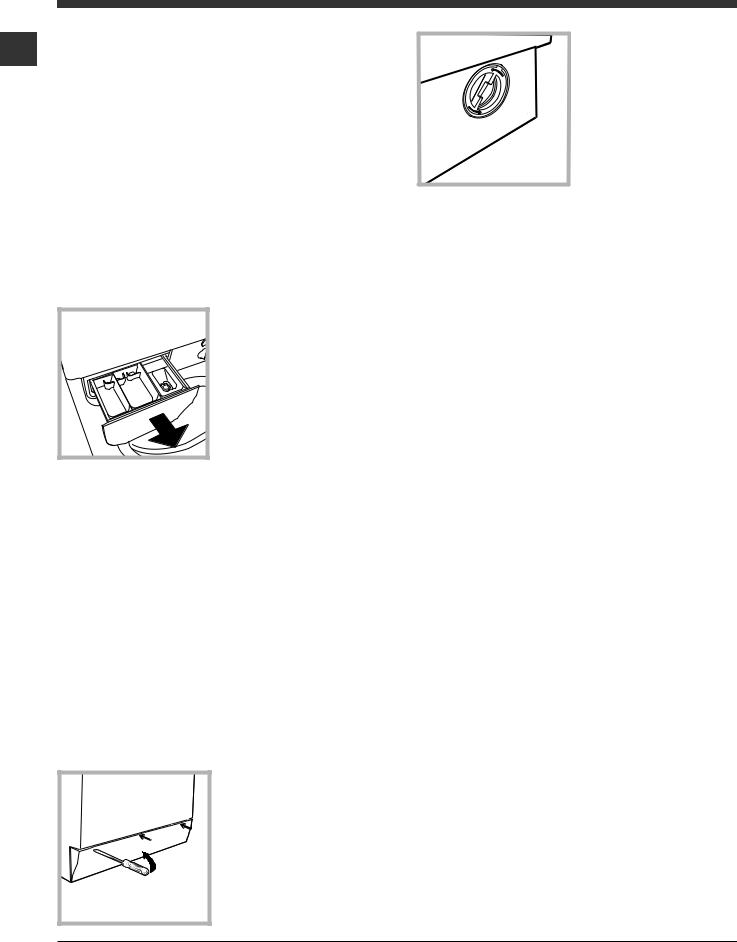
Care and maintenance
Cutting off the water and electricity GB supplies
•Turn off the water tap after every wash cycle. This will limit wear on the hydraulic system inside the washing machine and help to prevent leaks.
•Unplug the washing machine when cleaning it and during all maintenance work.
Cleaning the washing machine
The outer parts and rubber components of the appliance can be cleaned using a soft cloth soaked in lukewarm soapy water. Do not use solvents or abrasives.
Cleaning the detergent dispenser drawer
Remove the dispenser by raising it and pulling it out (see figure).
Wash it under running water; this operation should be repeated frequently.
2. unscrew the lid by rotating it anti-clockwise (see figure): a little water may trickle out. This is perfectly normal;
3.clean the inside thoroughly;
4.screw the lid back on;
5.reposition the panel, making sure the hooks are securely in place before you push it onto the appliance.
Checking the water inlet hose
Check the inlet hose at least once a year. If there are any cracks, it should be replaced immediately: during the wash cycles, water pressure is very strong and a cracked hose could easily split open.
! Never use second-hand hoses.
Caring for the door and drum of your appliance
•Always leave the porthole door ajar in order to prevent unpleasant odours from forming.
Cleaning the pump
The washing machine is fitted with a self-cleaning pump which does not require any maintenance. Sometimes, small items (such as coins or buttons) may fall into the pre-cham- ber which protects the pump, situated in its bottom part.
! Make sure the wash cycle has finished and unplug the appliance.
To access the pre-chamber:
1. using a screwdriver, remove the cover panel on the lower front part of the washing machine (see figure);
10

Troubleshooting
Your washing machine could fail to work. Before contacting the Technical Assistance Centre (see “Assistance”), make sure |
GB |
that the problem cannot be solved easily using the following list. |
Problem:
The washing machine does not switch on.
The wash cycle does not start.
Possible causes / Solutions:
•The appliance is not plugged into the socket fully, or is not making contact.
•There is no power in the house.
•The washing machine door is not closed properly.
•The ON/OFF button has not been pressed.
•The START/PAUSE button has not been pressed.
•The water tap has not been opened.
•A delayed start has been set (see “Personalisation”).
The washing machine does not take in water (the indicator light for the first wash cycle stage flashes rapidly).
•The water inlet hose is not connected to the tap.
•The hose is bent.
•The water tap has not been opened.
•There is no water supply in the house.
•The pressure is too low.
•The START/PAUSE button has not been pressed.
The washing machine continuously • The drain hose is not fitted at a height between 65 and 100 cm from the floor takes in and drains water. (see “Installation”).
•The free end of the hose is under water (see “Installation”).
•The wall drainage system is not fitted with a breather pipe.
If the problem persists even after these checks, turn off the water tap, switch the appliance off and contact the Assistance Service. If the dwelling is on one of the upper floors of a building, there may be problems relating to water drainage, causing the washing machine to fill with water and drain continuously. Special anti-draining valves are available in shops and help to avoid this inconvenience.
The washing machine does not drain or spin.
•The wash cycle does not include draining: some wash cycles require the drain phase to be started manually.
•The drain hose is bent (see “Installation”).
•The drainage duct is clogged.
The washing machine vibrates a lot • The drum was not unlocked correctly during installation (see “Installation”). during the spin cycle. • The washing machine is not level (see “Installation”).
• The washing machine is trapped between cabinets and walls (see “Installation”).
The washing machine leaks. • The water inlet hose is not screwed on properly (see “Installation”).
•The detergent dispenser drawer is blocked (for cleaning instructions, see “Care and maintenance”).
•The drain hose is not fixed properly (see “Installation”).
The “option” indicator lights and the “start/pause” indicator light flash, while one of the “phase in progress” indicator lights and the “door locked” indicator light will remain lit in a fixed manner.
•Switch off the machine and unplug it, wait for approximately 1 minute and then switch it back on again.
If the problem persists, contact the Technical Assistance Service.
There is too much foam.
•The detergent is not suitable for machine washing (it should display the text “for washing machines” or “hand and machine wash”, or the like).
•Too much detergent was used.
11

Service
|
|
|
|
|
|
Before calling for Assistance: |
|
GB |
|||
|
• Check whether you can solve the problem alone (see “Troubleshooting”); |
||
|
|
• Restart the programme to check whether the problem has been solved; |
|
|
|||
|
|
• If this is not the case, contact an authorised Technical Assistance Centre using the telephone number provided on the |
|
|
|
guarantee certificate. |
|
|
|
! Always request the assistance of authorised technicians. |
Have the following information to hand:
•the type of problem;
•the appliance model (Mod.);
•the serial number (S/N).
This information can be found on the data plate applied to the rear of the washing machine, and can also be found on the front of the appliance by opening the door.
12

Manual de instrucciones
LAVADORA
ES
Español
Sumario |
ES |
|
Instalación, 14-15
Desembalaje y nivelación
Conexiones hidráulicas y eléctricas
Primer ciclo de lavado
Datos técnicos
IWC 61251
Descripción de la lavadora y comienzo de un programa, 16-17
Panel de control Pilotos
Poner en marcha un programa
Programas, 18
Tabla de programas
Personalizaciones, 19
Seleccionar la temperatura
Seleccionar el centrifugado
Funciones
Detergentes y ropa, 20
Contenedor de detergentes
Preparar la ropa
Prendas especiales
Sistema de equilibrado de la carga
Precauciones y consejos, 21
Seguridad general
Eliminaciones
Mantenimiento y cuidados, 22
Interrumpir el agua y la corriente eléctrica Limpiar la lavadora
Limpiar el contenedor de detergentes Cuidar la puerta y el cesto
Limpiar la bomba
Controlar el tubo de alimentación de agua
Anomalías y soluciones, 23
Asistencia, 24
13
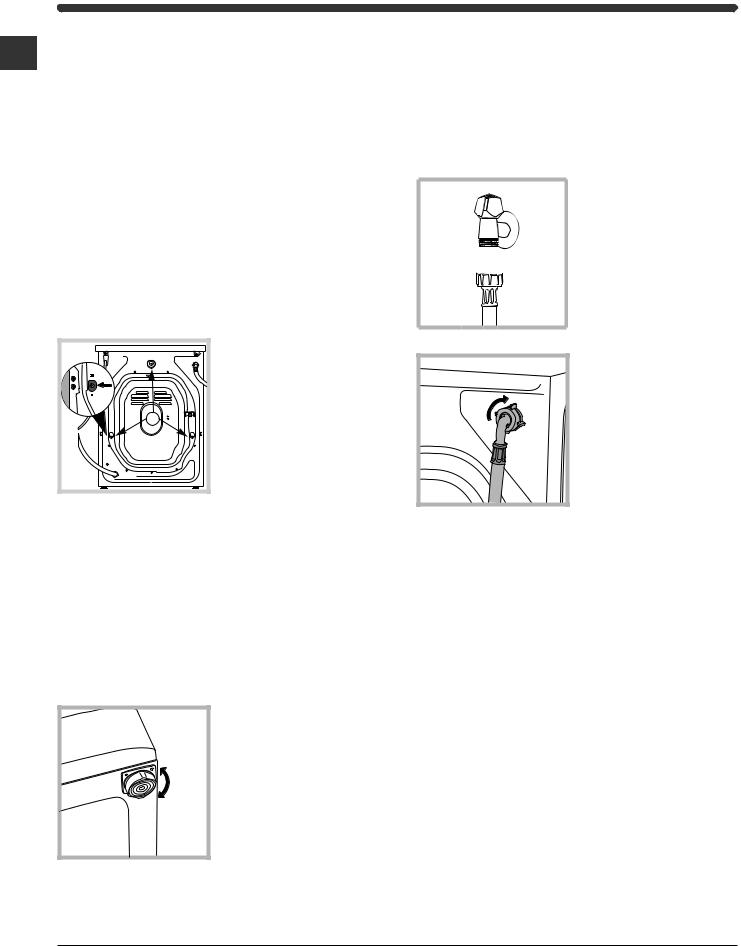
Instalación
! Es importante conservar este manual para poder consul- ES tarlo en cualquier momento. En caso de venta, de cesión o
de traslado, verifique que permanezca junto con la lavadora para informar al nuevo propietario sobre el funcionamiento y brindar las correspondientes advertencias.
! Lea atentamente las instrucciones: ellas contienen importante información sobre la instalación, el uso y la seguridad.
Desembalaje y nivelación
Desembalaje
1.Desembale la lavadora.
2.Controle que la lavadora no haya sufrido daños durante el transporte. Si estuviera dañada no la conecte y llame al revendedor.
3. Quite los 3 tornillos de protección para el transporte y la arandela de goma con el correspondiente distanciador ubicados en la parte posterior (ver la figura).
4.Cubra los orificios con los tapones de plástico suministrados con el aparato.
5.Conserve todas las piezas: cuando la lavadora deba ser transportada nuevamente, deberán volver a colocarse.
! Los embalajes no son juguetes para los niños.
Nivelación
1. Instale la lavadora sobre un piso plano y rígido, sin apoyarla en las paredes, muebles ni en ningún otro aparato.
2. Si el piso no está perfectamente horizontal, compense las irregularidades desenroscando o enroscan-
do las patas delanteras
(ver la figura); el ángulo de inclinación medido sobre la superficie de trabajo, no debe superar los 2º.
Una cuidadosa nivelación brinda estabilidad a la
máquina y evita vibraciones, ruidos y desplazamientos du-
rante el funcionamiento. Cuando se instala sobre moquetas o alfombras, regule los pies para conservar debajo de la lavadora un espacio suficiente para la ventilación.
Conexiones hidráulicas y eléctricas
Conexión del tubo de alimentación de agua
1. Conectar el tubo de tubo enroscándolo a un grifo de agua fría con la boca roscada de 3/4 gas (ver la figura).
Antes de conectarlo, haga correr el agua hasta que esté límpida.
2. Conecte el tubo de alimentación a la lavadora enroscándolo en la toma de agua correspondiente ubicada en la parte posterior derecha (arriba) (ver la figura).
3. Controle que en el tubo no hayan pliegues ni estrangulaciones.
!La presión de agua del grifo debe estar comprendida dentro de los valores contenidos en la tabla de Datos técnicos (ver la página correspondiente).
!Si la longitud del tubo de alimentación no es la suficiente, diríjase a un negocio especializado o a un técnico autorizado.
!No utilice nunca tubos ya usados.
!Utilice los suministrados con la máquina.
14
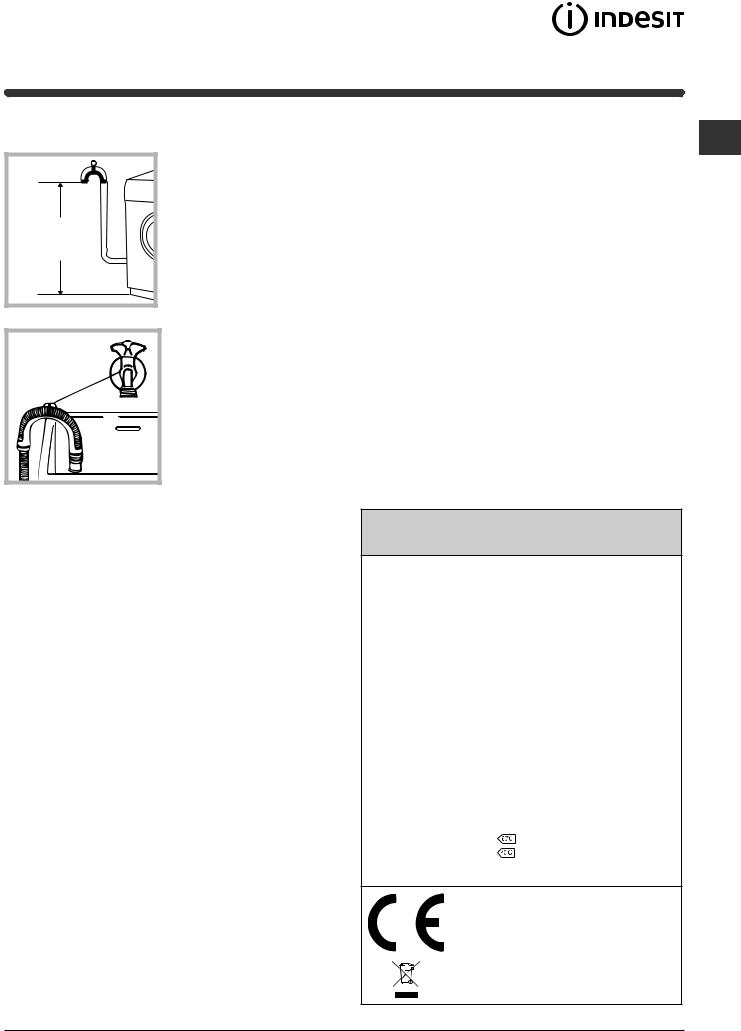
Conexión del tubo de descarga
65 - 100 cm |
Conecte el tubo de descarga, sin plegarlo, a una tubería de descarga o a una descarga de pared colocadas a una altura del piso entre 65 y 100 cm;
o apóyelo en el borde de un lavamanos o de una bañera, uniendo la guía suministrada con el aparato, al grifo (ver la
figura). El extremo libre del tubo de descarga no debe permanecer sumergido en el agua.
! No se aconseja utilizar tubos de prolongación, si fuera indispensable hacerlo, la prolongación debe tener el mismo diámetro del tubo original y no superar los 150 cm.
Conexión eléctrica
Antes de enchufar el aparato, verifique que:
•la toma tenga la conexión a tierra y haya sido hecha según las normas legales;
•la toma sea capaz de soportar la carga máxima de potencia de la máquina indicada en la tabla de Datos técnicos (ver al costado);
•la tensión de alimentación esté comprendida dentro de los valores indicados en la tabla de Datos técnicos (ver al costado);
•la toma sea compatible con el enchufe de la lavadora. Si no es así, sustituya la toma o el enchufe.
!La lavadora no debe ser instalada al aire libre, ni siquiera si el lugar está reparado, ya que es muy peligroso dejarla expuesta a la lluvia o a las tormentas.
!Una vez instalada la lavadora, la toma de corriente debe ser fácilmente accesible.
!No utilice prolongaciones ni conexiones múltiples.
! El cable no debe estar plegado ni sufrir compresiones.
ES
! El cable de alimentación debe ser sustituido sólo por técnicos autorizados.
¡Atención! La empresa fabricante declina toda responsabilidad en caso de que estas normas no sean respetadas.
Primer ciclo de lavado
Después de la instalación y antes del uso, realice un ciclo de lavado con detergente y sin ropa, seleccionando el programa 2.
Datos técnicos
Modelo |
IWC 61251 |
|
|
|
|
||
|
ancho 59,5 cm. |
||
Dimensiones |
altura 85 cm. |
|
|
|
profundidad 52,5 cm. |
||
|
|
|
|
Capacidad |
de 1 a 6 kg. |
|
|
|
|
||
Conexiones |
ver la placa de características técnicas aplicada |
||
eléctricas |
en la máquina |
||
|
|
||
Conexiones |
presión máxima 1 MPa (10 bar) |
||
presión mínima 0,05 MPa (0,5 bar) |
|||
hídricas |
|||
capacidad del cesto 46 litros |
|||
|
|||
|
|
|
|
Velocidad de |
máxima 1200 r.p.m. |
||
centrifugado |
|||
|
|
||
|
|
|
|
Programas de |
|
|
|
control según |
Programa :programanormaldealgodóna60°C; |
||
las directivas |
Programa |
: programanormal de algodóna40°C. |
|
1061/2010 y |
|
|
|
1015/2010 |
|
|
|
Esta máquina cumple con lo establecido por las siguientes Directivas de la Comunidad:
-2004/108/CE (Compatibilidad Electromagnética)
-2002/96/CE
-2006/95/CE (Baja Tensión)
15
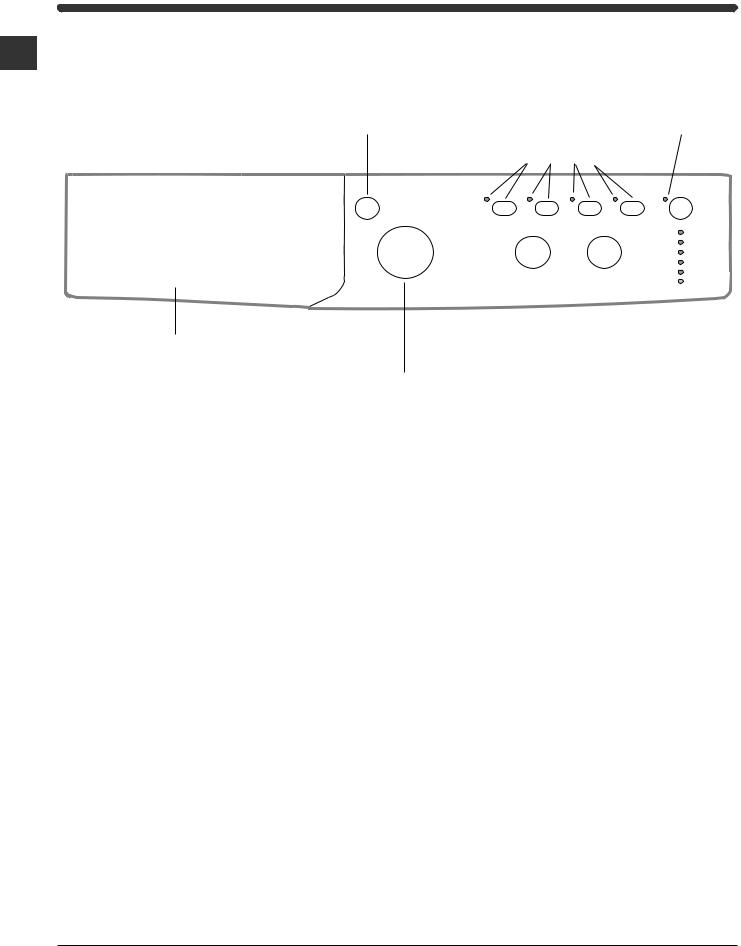
Descripción de la lavadora y comienzo de un programa
Panel de control
ES
Botón de ON/OFF
Contenedor de detergentes
Mando de
PROGRAMAS
Contenedor de detergentes: para cargar detergentes y aditivos (ver “Detergentes y ropa”).
Botón de ON/OFF: para encender y apagar la lavadora.
Mando de PROGRAMAS: para elegir los programas. Durante el funcionamiento del programa el mando no se mueve.
Botones con pilotos de FUNCIÓN: para seleccionar las funciones disponibles. El piloto correspondiente a la función seleccionada permanecerá encendido.
Mando de CENTRIFUGADO: para seleccionar el centrifugado o excluirlo (ver “Personalizaciones”).
Mando de TEMPERATURA: para seleccionar la temperatura o el lavado en frío (ver “Personalizaciones”).
Pilotos DE AVANCE DEL CICLO/COMIENZO RETRASADO: para seguir el estado de avance del programa de lavado.
El piloto encendido indica la fase en curso.
Si se seleccionó la función “Comienzo retrasado”, indicarán el tiempo que falta para la puesta en marcha del programa (ver la página correspondiente).
Pilotos DE AVANCE DEL
CICLO/COMIENZO
RETRASADO
|
|
|
|
Botón con |
Botones con pilotos |
|
|
|
piloto START/ |
|
||||
FUNCIÓN |
|
|
|
PAUSE |
|
|
|
|
|
|
|
|
|
|
|
|
|
|
|
|
|
|
|
|
|
|
|
|
|
|
|
|
|
|
Mando de |
|
|
|
|
|
|
|
|
|
|
|
Piloto PUERTA |
||
TEMPERATURA |
|
|
BLOQUEADA |
|
|
||||
|
|
|
||
|
|
Mando de |
|
|
CENTRIFUGADO |
|
|
||
|
|
|||
Piloto PUERTA BLOQUEADA: para saber si la puerta se puede abrir (ver la página correspondiente).
Botón con piloto START/PAUSE: se utiliza para poner en marcha los programas o interrumpirlos momentáneamente.
Nota: Presione este botón para poner en pausa el lavado en curso, el piloto correspondiente centelleará con color anaranjado mientras que el de la fase en curso permanecerá encendido en forma fija. Si el piloto PUERTA BLOQUEADA  está apagado, se podrá abrir la puerta. Para que el lavado se reanude a partir del momento en el cual fue interrumpido, presione nuevamente este botón.
está apagado, se podrá abrir la puerta. Para que el lavado se reanude a partir del momento en el cual fue interrumpido, presione nuevamente este botón.
Modalidad de stand by
Esta lavadora está en conformidad con las nuevas normativas vinculadas al ahorro energético. Está dotada de un sistema de auto-apagado (stand by) que, en caso de no funcionamiento, se activa pasados aproximadamente 30 minutos. Presionar brevemente el botón ON/OFF y esperar que la máquina se active.
Consumo en off-mode: 1 W Consumo en Left-on: 1 W
16
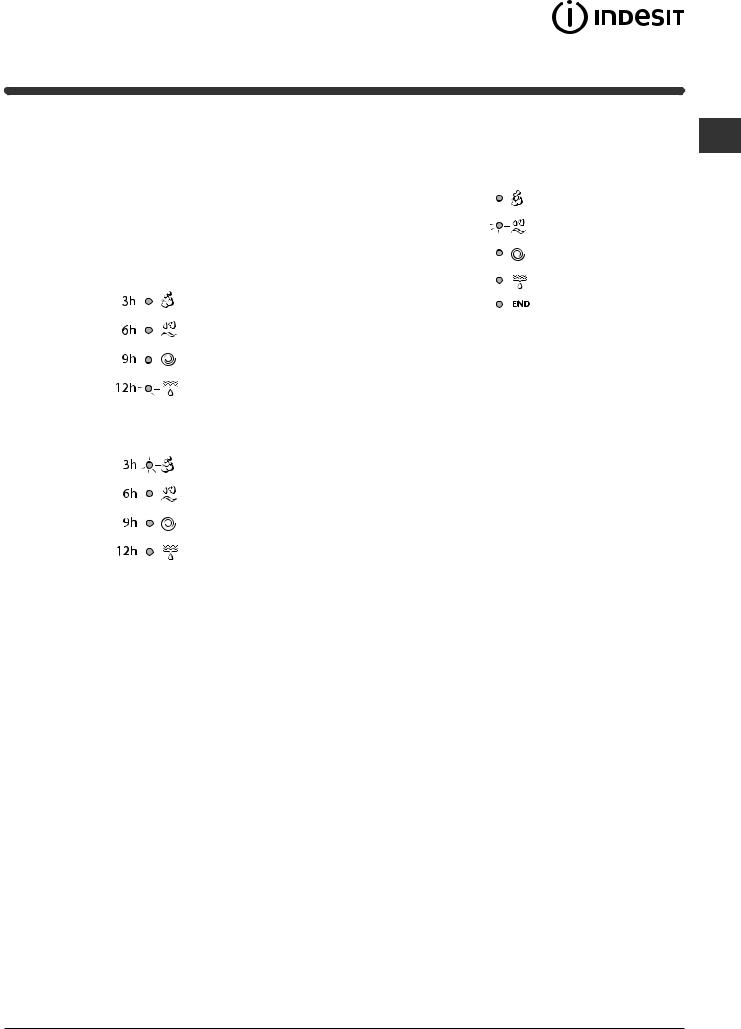
Pilotos
Los pilotos suministran información importante. He aquí lo que nos dicen:
Comienzo retrasado
Si se ha activado la función “Comienzo retrasado” (ver “Personalizaciones”), después de haber puesto en marcha el programa, comenzará a centellear el piloto correspondiente al retraso seleccionado:
Con el transcurrir del tiempo se visualizará el retraso residual con el centelleo de la luz testigo correspondiente:
Una vez transcurrido el tiempo de retraso seleccionado, comenzará el programa.
Pilotos fase en curso
Una vez seleccionado y puesto en marcha el ciclo de ES lavado deseado, las luces testigo se encenderán progresivamente para indicar su estado de avance:
Lavado
Aclarado
Centrifugado
Descarga
Fin del Lavado
Botones de función y pilotos correspondientes
Seleccionando una función, el piloto correspondiente se iluminará. Si la función seleccionada no es compatible con el programa elegido, el piloto correspondiente centelleará y la función no se activará. Si la función elegida no es compatible con otra seleccionada precedentemente, el piloto correspondiente a la primera función seleccionada centelleará y se activará sólo la segunda, el piloto de la función activada se iluminará.
 Piloto puerta bloqueada
Piloto puerta bloqueada
El piloto encendido indica que la puerta está bloqueada impidiendo su apertura; para poder abrir la puerta es necesario que dicho piloto esté apagado (espere 3 minutos aproximadamente). Para abrir la puerta mientras un ciclo está en curso, presione el botón START/PAUSE; si el piloto PUERTA BLOQUEADA está apagado, será posible abrir la puerta.
Poner en marcha un programa
1.Encienda la lavadora presionando el botón ON/OFF. Todos los pilotos se encenderán durante algunos segundos, luego se apagarán y se deberá pulsar el piloto START/PAUSE.
2.Cargue la ropa y cierre la puerta.
3.Seleccione el programa deseado con el mando de PROGRAMAS.
4.Fije la temperatura de lavado (ver “Personalizaciones”).
5.Fije la velocidad de centrifugado (ver “Personalizaciones”).
6.Vierta detergente y aditivos (ver “Detergentes y ropa”).
7.Seleccione las funciones deseadas.
8.Ponga en marcha el programa presionando el botón START/PAUSE y el piloto correspondiente permanecerá encendido, fijo y de color verde. Para anular el ciclo seleccionado ponga en pausa la máquina presionando el botón START/PAUSE y elija un nuevo ciclo.
9.Al final del programa se iluminará el piloto
 . Cuando el piloto PUERTA BLOQUEADA
. Cuando el piloto PUERTA BLOQUEADA  se apague, será posible abrir la puerta. Extraiga la ropa y deje la puerta semicerrada para permitir que el cesto se seque.
se apague, será posible abrir la puerta. Extraiga la ropa y deje la puerta semicerrada para permitir que el cesto se seque.
Apague la lavadora presionando el botón ON/OFF.
17
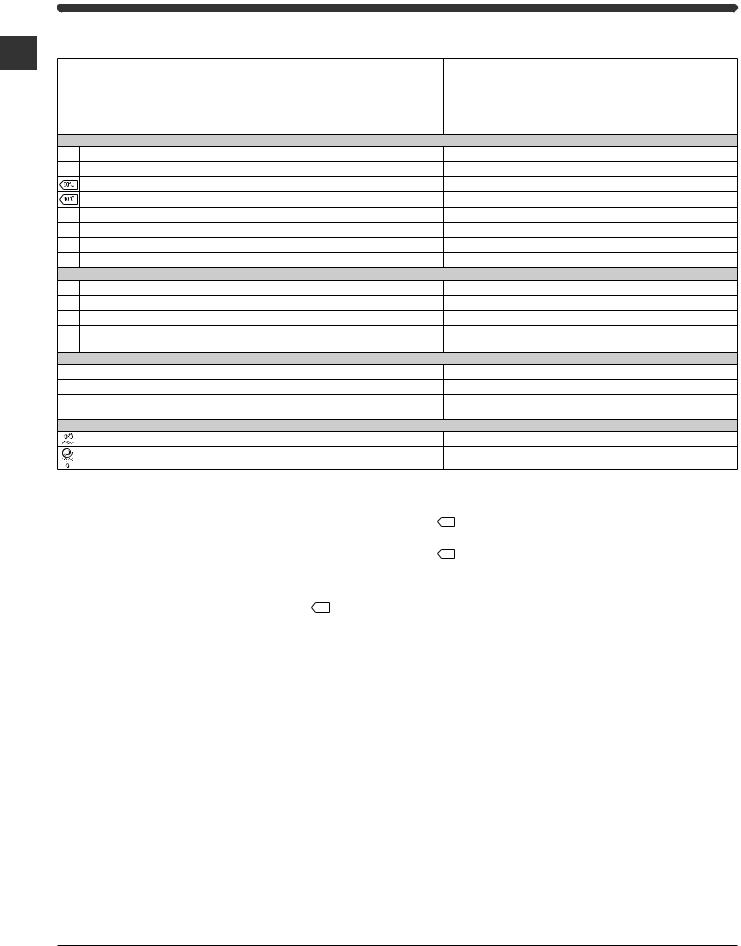
Programas
Tabla de programas
ES
Programas |
Descripción del Programa |
|
|
|
Diario (Daily) |
|
|
1 |
Prelavado Algodón: blancos sumamente sucios. |
2 |
Algodón: blancos sumamente sucios. |
|
Programa normal de algodón a 60 °C (1): blancos y colores resistentes muy sucios. |
|
Programa normal de algodón a 40 °C (2): blancos y colores delicados muy sucios. |
5 |
Algodón de color: blancos poco sucios y colores delicados. |
6Sintético: colores resistentes muy sucios.
6Sintético (3): colores resistentes poco sucios.
7 Programa normal de algodón a 20 °C
Programas Especiales (Special)
8 Lana: para lana, cachemira, etc.
9 |
Seda/Cortinas: para prendas de seda, viscosa, lencería. |
10 |
Jeans |
11 |
Express: para refrescar rápidamente prendas poco sucias (no se aconseja utilizarlo para |
lana, seda y prendas para lavar a mano). |
|
|
Sport |
12 |
Sport Intensive |
13 |
Sport Light |
14 |
Special Shoes |
|
Programas Parciales |
|
|
|
Aclarado |
|
Centrifugado + Descarga |
|
|
|
|
Detergentes |
máx.Carga(Kg.) |
|
|
totalAgualt |
Duracióndel ciclo |
||||
|
|
Prelavado |
|
Lavado |
|
Suavizante |
residual |
Consumo |
|||
|
|
|
|
|
|
|
|
% |
de |
|
|
Temp. |
Velocidad |
|
|
|
|
|
|
Humedad |
kWh energía |
|
|
max. |
máx. |
|
|
|
|
|
|
|
|
|
|
(°C) |
(r.p.m.) |
|
|
|
|
|
|
|
|
|
|
90° |
|
|
|
|
|
|
|
|
|
|
150’ |
|
|
|
|
|
|
|
|||||
1200 |
|
|
6 |
53 |
1,84 |
64 |
|||||
90° |
1200 |
- |
|
|
|
|
6 |
53 |
1,77 |
58 |
135’ |
60° |
1200 |
- |
|
|
|
|
6 |
53 |
0,98 |
51 |
190’ |
40° |
1200 |
- |
|
|
|
|
6 |
53 |
0,86 |
52 |
185’ |
40° |
1200 |
- |
|
|
|
|
6 |
53 |
0,82 |
53 |
90’ |
60° |
800 |
- |
|
|
|
|
2,5 |
44 |
0,78 |
33 |
100’ |
40° |
800 |
- |
|
|
|
|
2,5 |
44 |
0,49 |
32 |
90’ |
20° |
1200 |
- |
|
|
|
|
6 |
- |
- |
- |
170’ |
40° |
|
|
|
|
|
|
|
|
|
|
70’ |
800 |
- |
|
|
1,5 |
- |
- |
- |
||||
30° |
0 |
- |
|
|
|
|
1 |
- |
- |
- |
55’ |
40° |
800 |
- |
|
|
|
|
3 |
- |
- |
- |
60’ |
30° |
800 |
- |
|
|
|
|
1,5 |
71 |
0,12 |
27 |
15’ |
30° |
|
|
|
|
|
|
|
|
|
|
85’ |
|
|
|
|
|
|
|
|
||||
600 |
- |
|
|
3 |
- |
- |
- |
||||
30° |
600 |
- |
|
|
|
|
3 |
- |
- |
- |
60’ |
30° |
600 |
- |
|
|
|
|
Max.2 |
- |
- |
- |
55’ |
|
|
pares |
|||||||||
- |
|
|
|
|
|
|
|
|
|
36’ |
|
1200 |
- |
|
- |
|
6 |
- |
- |
- |
|||
- |
1200 |
- |
|
- |
|
- |
6 |
- |
- |
- |
16’ |
|
|
|
|
|
|
|
|
|
|
|
|
La duración del ciclo que se indica en el visor o en el manual es una estimación calculada en base a condiciones estándar. El tiempo efectivo puede variar en función de numerosos factores como la temperatura y la presión del agua de entrada, la temperatura ambiente, la cantidad de detergente, la cantidad y el tipo de carga, el equilibrado de la carga y las opciones adicionales seleccionadas.
1) Programa de control según la directiva 1061/2010: seleccione el programa 
 con una temperatura de 60ºC.
con una temperatura de 60ºC.
Este ciclo es adecuado para limpiar una carga de algodón normalmente sucia, es el más eficiente en lo que se refiere al consumo combinado con la energía y la cantidad de agua y se usa con prendas lavables a 60ºC. La temperatura efectiva de lavado puede diferir de la indicada.
2) Programa de control según la directiva 1061/2010: seleccione el programa 
 con una temperatura de 40ºC.
con una temperatura de 40ºC.
Este ciclo es adecuado para limpiar una carga de algodón normalmente sucia, es el más eficiente en lo que se refiere al consumo combinado con la energía y la cantidad de agua y se usa con prendas lavables a 40ºC. La temperatura efectiva de lavado puede diferir de la indicada.
Para todos los Test Institutes:
2)Programa algodón largo: seleccione el programa 
 con una temperatura de 40ºC.
con una temperatura de 40ºC.
3)Programa sintético largo: seleccione el programa 6 con una temperatura de 40ºC.
Programa normal de algodón a 20 °C (programa 7) ideal para cargas de prendas de algodón sucias. Los buenos rendimientos aún en frío, comparables con los de un lavado a 40º, están garantizados por una acción mecánica que trabaja con variación de velocidad con picos repetidos y cercanos.
Express (programa 11) fue estudiado para lavar prendas ligeramente sucias y en poco tiempo: dura sólo 15 minutos y de esa manera permite ahorrar energía y tiempo. Seleccionando el programa (11 a 30ºC) es posible lavar conjuntamente tejidos de distinto tipo (excluidas lana y seda), con una carga máxima de 1,5 kg.
Sport Intensive (programa 12) ha sido estudiado para lavar tejidos usados en prendas deportivas (chándales, pantalones cortos, etc.) muy sucios; para obtener los mejores resultados es aconsejable no superar la carga máxima indicada en la
“Tabla de programas”.
Sport Light (programa 13) ha sido estudiado para lavar tejidos usados en prendas deportivas (chándales, pantalones cortos, etc.) poco sucios; para obtener los mejores resultados es aconsejable no superar la carga máxima indicada en la “Tabla de programas”. Se recomienda utilizar detergente líquido y la dosis correspondiente a la media carga.
Special Shoes (programa 14) ha sido estudiado para lavar calzado deportivo; para obtener los mejores resultados no lave más de 2 pares a la vez.
18
